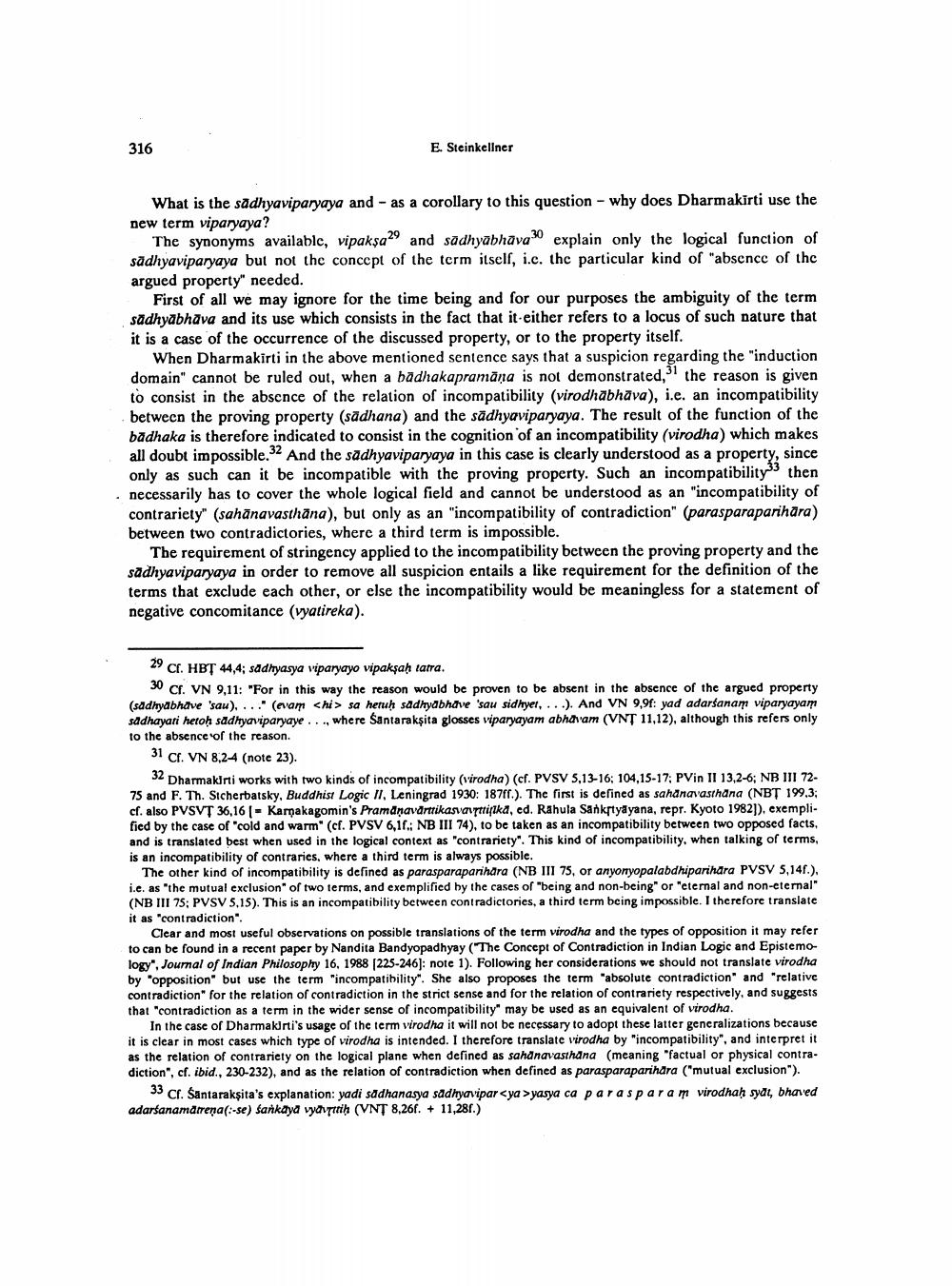Book Title: Logic Of Svabhavahetu In Dhharmakirtis Vadanyaya Author(s): Ernat Steinkellner Publisher: Ernat Steinkellner View full book textPage 6
________________ 316 E. Steinkellner What is the sadhyaviparyaya and - as a corollary to this question - why does Dharmakirti use the new term viparyaya? The synonyms available, vipaksa 29 and sādhyābhāva 30 explain only the logical function of sadhyaviparyaya but not the concept of the term itsell, i.e. the particular kind of "absence of the argued property" needed. First of all we may ignore for the time being and for our purposes the ambiguity of the term sadhyabhava and its use which consists in the fact that it either refers to a locus of such nature that it is a case of the occurrence of the discussed property, or to the property itself. When Dharmakirti in the above mentioned sentence says that a suspicion regarding the "induction domain" cannot be ruled out, when a badhakapramāņa is not demonstrated," the reason is given to consist in the absence of the relation of incompatibility (virodhābhāva), i.e. an incompatibility between the proving property (sadhana) and the sādhyaviparyaya. The result of the function of the badhaka is therefore indicated to consist in the cognition of an incompatibility (virodha) which makes all doubt impossible. And the sadhyaviparyaya in this case is clearly understood as a property, since only as such can it be incompatible with the proving property. Such an incompatibility then • necessarily has to cover the whole logical field and cannot be understood as an "incompatibility of contrariety" (sahānavasthana), but only as an "incompatibility of contradiction" (parasparaparihara) between two contradictories, where a third term is impossible. The requirement of stringency applied to the incompatibility between the proving property and the sadhyaviparyaya in order to remove all suspicion entails a like requirement for the definition of the terms that exclude each other, or else the incompatibility would be meaningless for a statement of negative concomitance (vyatireka). 29 Cr. HBT 44,4; sadryasya viparyayo vipaksah tatra. SU C. VN 9,11: "For in this way the reason would be proven to be absent in the absence of the argued property (sadhyabhave 'sau), ..." (avam <hi > sa heruh sadhyabhave 'sau sidhyer, ...). And VN 9,96: yad adarśanam viparyayam sadhayari hetoh sadhyaviparyaye ..., where Santara kşita glosses viparyayam abhavam (VNT 11,12), although this refers only to the absence of the reason. 31 Ch. VN 8,2-4 (note 23). 32 Dharmakini works with two kinds of incompatibility (virodha) (cf. PVSV 5.13-16; 104,15-17; PVin II 13,2-6; NB III 7275 and F. Th. Sicherbatsky, Buddhist Logic II, Leningrad 1930: 187ff.). The first is defined as sahanavasthana (NBT 199,3; cf. also PVSVT 36,16 - Karakagomin's Pramanavdrttikasvattisika, ed. Rahula Sankrtyayana, repr. Kyoto 1982]). exemplified by the case of cold and warm" (cf. PVSV 6,11; NB III 74), to be taken as an incompatibility between two opposed facts, and is translated best when used in the logical context as 'contrariety". This kind of incompatibility, when talking of terms, is an incompatibility of contrarics, where a third term is always possible. The other kind of incompatibility is defined as parasparaparihara (NB III 75, or anyonyopalabdhiparihara PVSV 5,141.), i.e. as "the mutual exclusion of two terms, and exemplified by the cases of being and non-being" or "eternal and non-eternal" (NB III 75: PVSV 5.15). This is an incompatibility between contradictories, a third tcrm being impossible. it as 'contradiction". Clear and most useful observations on possible translations of the term virodha and the types of opposition it may refer to can be found in a recent paper by Nandita Bandyopadhyay ("The Concept of Contradiction in Indian Logic and Epistemology", Journal of Indian Philosophy 16, 1988 (225-246): note 1). Following her considerations we should not translate virodha by "opposition" but use the term "incompatibility". She also proposes the term "absolute contradiction" and "relative contradiction for the relation of contradiction in the strict sense and for the relation of contrariety respectively, and suggests that "contradiction as a term in the wider sense of incompatibility may be used as an equivalent of virodha. In the case of Dharmakirti's usage of the term virodha it will not be necessary to adopt these latter generalizations because it is clear in most cases which type of virodha is intended. I therefore translate virodha by "incompatibility, and interpret it as the relation of contrariety on the logical plane when defined as sahanavasthana (meaning "actual or physical contradiction", cf. ibid., 230-232), and as the relation of contradiction when defined as parasparaparihara ("mutual exclusion"). 33 cr. Santaraksita's explanation: yadi sadhanasya sadhyavipar <ya >yasya ca parasparam virodhah syat, bhaved adarsanamarrena(:-se) Sankaya vyavretih (VNT 8,26f. + 11,281.)Page Navigation
1 ... 4 5 6 7 8 9 10 11 12 13
